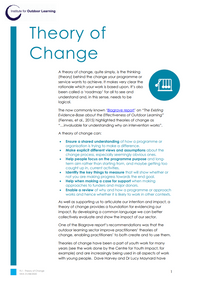Theory of Change
A Simplified Theory of Change Model

- The identified need shapes the boundaries of the programme or service – what you want to be different, for whom, and in what way.
- Underpinning assumptions are the research, theories, models and beliefs that support your approach. Some elements might be hidden as part of “the way we do things round here.”
- Resources and constraints are the building blocks required to achieve the programme objectives, such as people, skills, facilities, equipment, time and finance. A programme uses these inputs to provide activities.
- Planned activities are the purposeful experiences that take place, or the services provided. Activities result in outputs - measurable data about what has happened (who participated, activities completed, when did it happen, etc.).
- Intended outcomes are the benefits for participants either during or following a programme. They are usually a change in knowledge, skills, behaviours, attitudes, etc. Indicators let you know whether an outcome has occurred and/or, by how much.
- Desired impacts are the long-term cumulative effects of the programme or service for individuals, their community and the wider world.
A theory of change can be presented in many ways – the best way is that which is most appropriate to your audience. A simple image is best supported by a written description.
Image by Neal Anderson developed from Measuring Programme Outcomes: A Practical Approach, United Way of America, 1996. Also see the Outdoor Education Programme Model, John Crosbie 2013, and the Think NPC Theory of Change in 10 Steps, James Noble 2019.
Applying your Theory of Change
The Institute for Outdoor Learning strongly encourage developing and applying a theory of change at the beginning of a programme (to support planning), during the programme (to support managing delivery), and to describe an existing programme (to support research and evaluation).
Read more...


